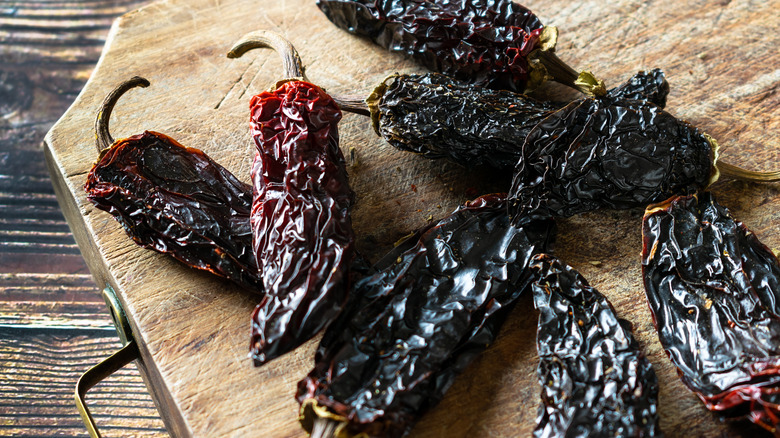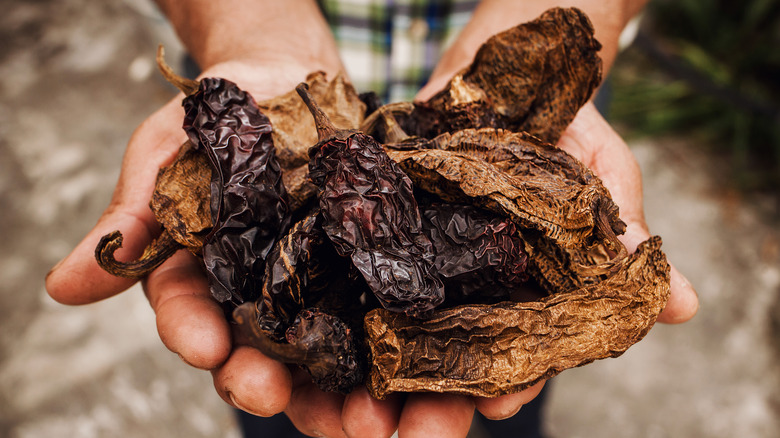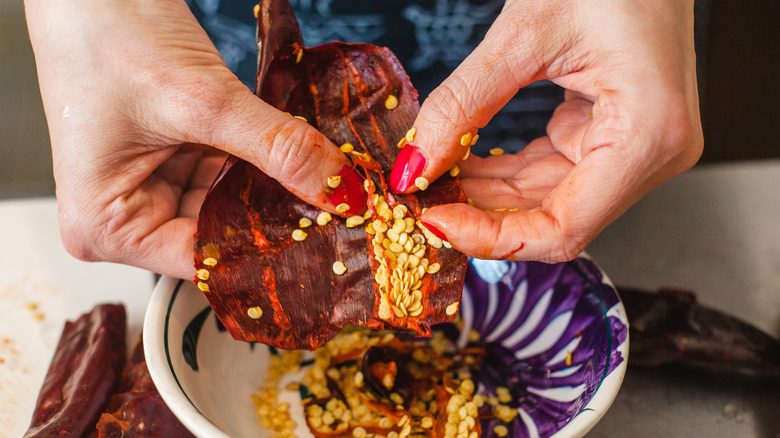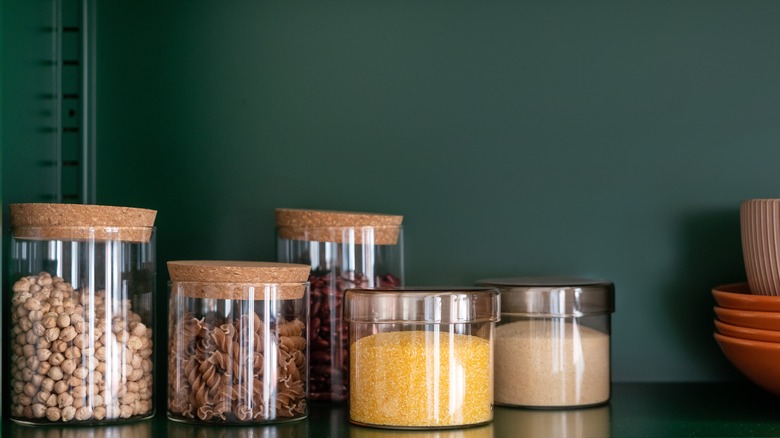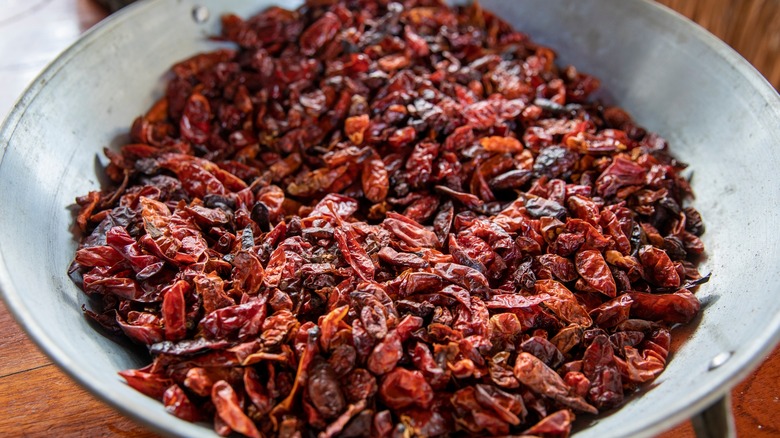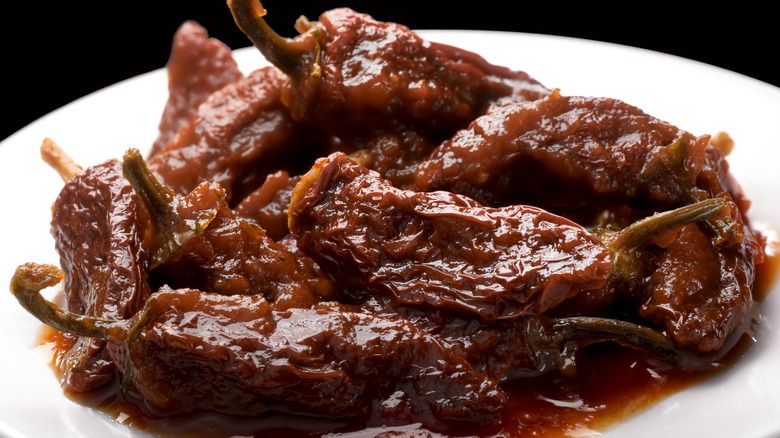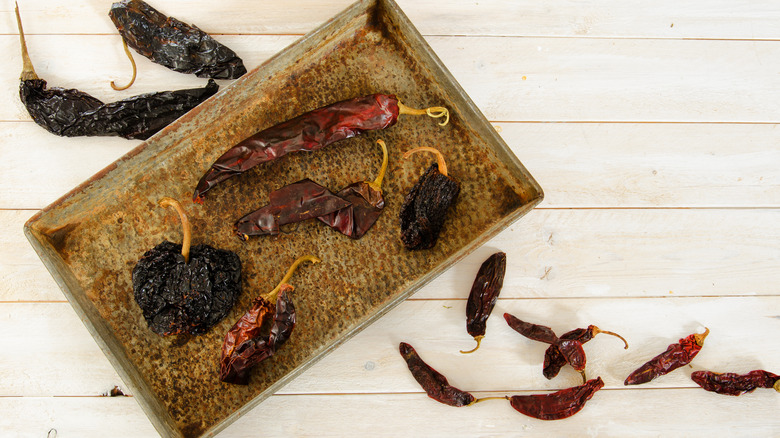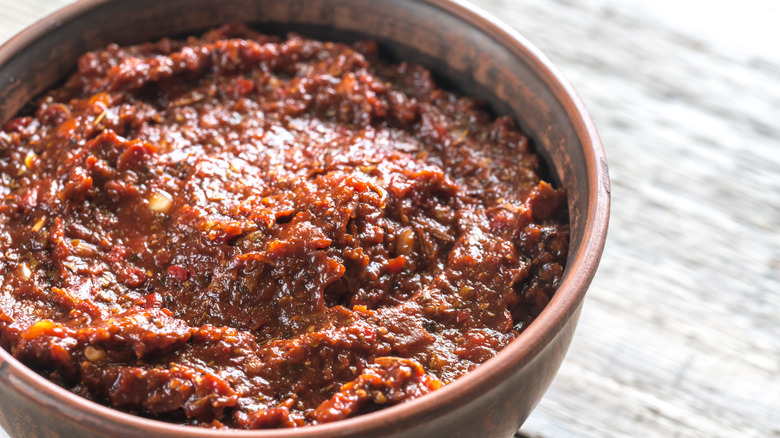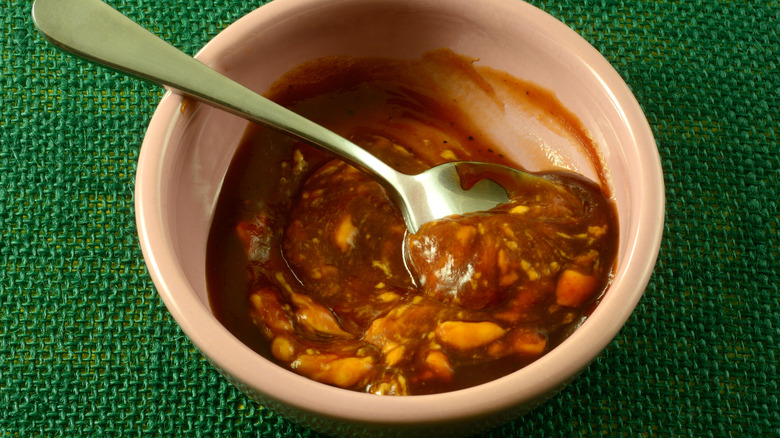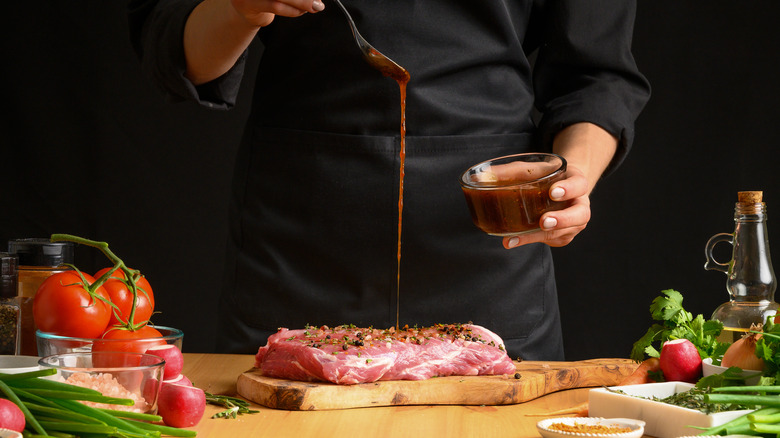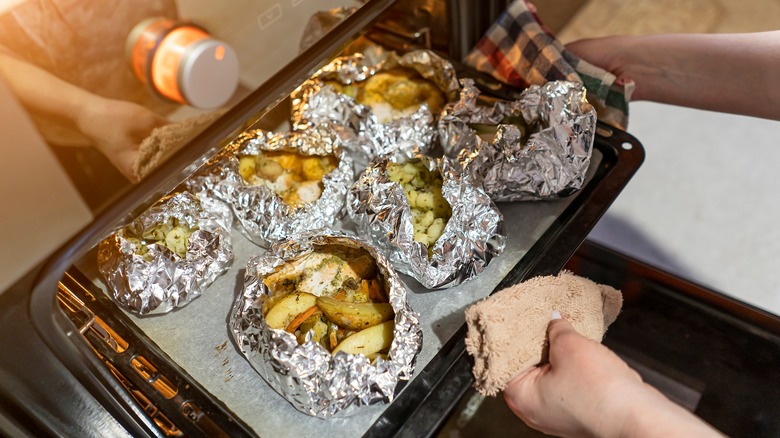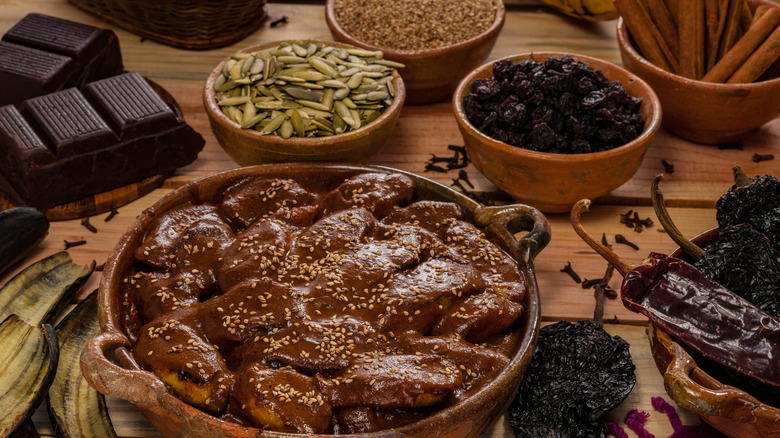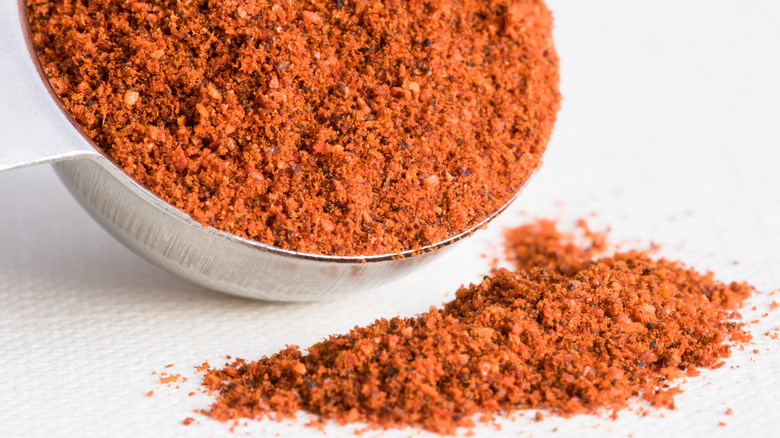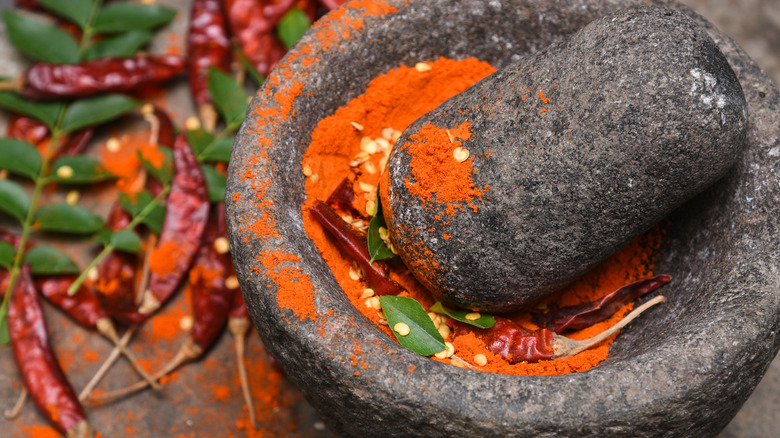13 Tips You Need When Cooking With Chipotles
Chipotle peppers have a long and interesting history, dating back to the ancient Aztecs of Mexico. The term 'chipotle' originates from the Nahuatl word chilpoctli, meaning smoked chili pepper. The ancient Aztecs used to smoke and dry jalapeño peppers for preservation purposes. In the 16th century, when the Spanish conquistadors landed in Mexico, they were fascinated by a unique culinary technique of smoking and drying peppers. This discovery amazed them so much that they eagerly carried it back to Europe. As time passed, the practice of incorporating smoked and dried peppers in Spanish cuisine gained popularity, and it eventually spread to other regions of the world.
A chipotle pepper isn't what you think it is. They are actually jalapeño peppers that have been smoked and dried to obtain a unique flavor. This unique processing gives chipotles their distinct grilled flavor and deep red color, which makes them a popular ingredient in Mexican cuisine and other dishes that call for a touch of smokiness. Besides their mouthwatering taste, chipotles are also renowned for their fiery heat, owing to the presence of capsaicin in them. While they're not the spiciest peppers out there, they still have enough kick to make your taste buds tingle!
Use the right kind of chipotle pepper for your dish
Knowing the various kinds of chipotle peppers is crucial for achieving the ideal combination of heat and flavor in your dishes when cooking with chipotles. The chipotle morita pepper is the most common variety of chipotle found in grocery stores and markets. Moritas are typically smaller and darker in color than their meco counterparts, with a deep reddish-brown hue.
Chipotle meco peppers are smoked for a more extended period, often up to twice as long as moritas, which results in a more robust, more intense charred flavor. In addition to the two main varieties of chipotle peppers, you'll also find them available in both dried and canned forms. Dried chipotles, whether morita or meco, can be rehydrated by placing them in hot water for about 15-30 minutes, which will make them pliable and easy to work with.
Canned chipotles, on the other hand, are typically morita peppers that have been rehydrated and packed in a tangy adobo sauce made from tomatoes, vinegar, garlic, and spices. The combination of singed peppers and zesty sauce makes canned chipotles an excellent choice for adding a burst of flavor to dishes like tacos, chili, and even scrambled eggs.
Pay attention to the heat levels
Not all chipotles pack the same punch when it comes to heat, and it's crucial to understand the nuances of their heat levels in order to create balanced and flavorful dishes. The Scoville Heat Unit (SHU) scale is commonly used to determine the level of spiciness in chili peppers, with mild bell peppers measuring 0 SHU and the world's spiciest peppers ranging over 2 million SHU. Chipotle moritas, the most common variety, has a heat level of 2,500 to 8,000 SHU, while chipotle mecos are milder, registering between 1,000 and 2,500 SHU.
One tip for managing the spiciness is to remove the seeds of the dried peppers, which contain a significant amount of the pepper's heat. Another approach to balancing the heat is by using a combination of chipotle peppers and other milder chili peppers, which we'll discuss a bit further. Alternatively, you can combine chipotles with ingredients that help to temper the heat, such as dairy products like sour cream or yogurt or sweet elements like honey or maple syrup.
Properly store dried chipotle peppers
Proper storage of chipotle peppers extends their shelf life and helps preserve their toasty taste and aroma. When storing dried chipotle peppers, the key is to keep them in a cool and dark place. Prolonged exposure to heat or moisture can lead to a decline in the flavor and color of the peppers.
Store canned chipotle peppers, commonly packed in adobo sauce, in a cool and dry area such as a pantry or cupboard until ready for use. After opening, transfer the peppers and sauce to an airtight container and refrigerate them. To maintain the best quality and flavor, use the refrigerated chipotles within a few days. If you believe you won't be able to use them within the specified time, consider freezing the remaining chipotle peppers. Portion the peppers and sauce into small freezer-safe containers or plastic bags and store them in the freezer for later use. To use the frozen chipotles, simply defrost them in the refrigerator or microwave before adding them to your recipe.
Prepare your chipotle peppers before cooking
Mastering chipotle preparation techniques is crucial for making the most of the smoldering flavor and heat in your recipes. From toasting dried chipotles to blending a smooth paste, each step can significantly impact the final taste and texture of your dish. Toasting spices (also known as blooming spices) is an excellent way to enhance their savory taste and unlock their full flavor potential. Just be careful not to toast them for too long, as this can result in a bitter taste.
If you prefer to reduce the heat level of your chipotle peppers, deseeding them is a simple yet effective way to do so. To remove the seeds, cut a slit along the side of the rehydrated or canned chipotle pepper and gently scrape out the seeds and membranes using a small spoon or the back of a knife. This will reduce the spiciness of the pepper while still retaining its charred flavor.
To create a smooth and consistent texture in your chipotle-based sauces or marinades, blending the peppers into a paste is an excellent technique. To do this, simply combine the rehydrated or canned chipotle peppers with a small amount of liquid, such as water, broth, or the adobo sauce from canned chipotles. Blend the mixture using a blender until it reaches your desired consistency.
Use adobo sauce for an additional smoky taste
Chipotle peppers in adobo sauce are a widely used and convenient means of adding the complex flavors of chipotle to your cooking. These canned options are typically chipotle morita peppers rehydrated and packed in a sauce made from tomatoes, vinegar, garlic, and spices. If you can't locate canned chipotle peppers in adobo sauce at your nearby grocery store, you can always whip up your own adobo sauce in the comfort of your home.
While chipotle peppers in adobo sauce offer a delicious combination of smoky heat and tangy zest, it's essential to balance these flavors in your dishes. The adobo sauce can have a strong flavor, so it's advisable to begin with a small quantity and tweak it to suit your taste buds. If you find the sauce too spicy or tangy, try balancing it with sweet ingredients like honey or maple syrup, or mellow it with dairy products like sour cream or yogurt.
Combine chipotle peppers with other peppers
While chipotle peppers bring a unique grilled flavor and moderate heat to your dishes, combining them with other types of chili peppers can create a more complex and layered taste experience. Guajillo peppers are mild, dried chili peppers that pair well with chipotles. With a heat level ranging from 2,500 to 5,000 SHU and a zesty, fruity flavor, guajillos can complement the roasted taste of chipotles without overwhelming the dish. Experiment with different combinations of chipotle and guajillo peppers in soups, stews, or marinades to create a distinctive blend of flavors.
An excellent pairing for chipotle peppers is ancho peppers, which are dried, ripened poblano peppers with a rich, fruity taste complemented by notes of raisin and plum. With a heat level ranging from 1,000 to 1,500 SHU, ancho chilies are not that spicy and can balance out the smokiness of chipotle peppers without adding too much heat. Consider using a combination of chipotle and ancho peppers in chili, enchilada sauce, or braised meat dishes. Serrano peppers can also be a great addition to chipotle-based dishes. With a heat level of 10,000 to 25,000 SHU, serrano peppers are incredibly spicy and provide a significant kick, along with a bright, fresh flavor. Combine chipotle and serrano peppers in salsas, hot sauces, or taco fillings for a fiery and charred flavor profile.
Make your own chipotle marinades and rubs
Adding chipotle-based marinades and rubs to your meats, seafood, or vegetables can produce dishes with a delightful toasty aroma and a wealth of flavors. From making your coffee-rubbed steak to cooking up delightful grilled chipotle lamb chops, creating your marinade or rub allows you to experiment with various ingredients and produce distinct flavor combinations.
Start with choosing the right kind of chipotle pepper. When selecting chipotles for your marinade or rub, choose plump peppers with a rich aroma. Examples of ingredients that you could incorporate for added flavor include honey for sweetness and lime juice for acidity. Choosing the right liquid is essential to help infuse the flavor into your meat or vegetables. Depending on the recipe, options for your marinade base could include olive oil or citrus juice. For a thicker consistency, you could also include ingredients such as tomato paste or soy sauce.
To ensure that your marinade or rub has a consistent flavor, it's important to blend all the ingredients thoroughly. Taste the marinade or rub while cooking, and adjust the seasoning if required. Pay close attention to the imagination time, too. If you're dealing with tougher cuts of meat, you might have to marinate them for several hours or even overnight.
Try out different chipotle sauces and condiments
Creating flavorful chipotle sauces and condiments is a fantastic way to elevate your dishes and showcase the singed, fire-roasted taste of chipotle peppers. A chipotle barbecue sauce is perfect for grilling, roasting, or even as a dipping sauce. This tangy sauce can be used on a variety of proteins like chicken, pork, or beef. Some delicious cooking ideas include barbecued chicken with pineapple and chipotle sauce and barbecue chipotle burgers.
For a creamy and charred condiment, try making a chipotle aioli. This versatile and creamy sauce can be used as a spread for sandwiches or burgers, a dip for fries or vegetables, or a drizzle for tacos and salads. You can also try making bacon taquitos with chipotle aioli for a dish that is equal parts crunchy, spicy, and earthy. Homemade chipotle salsa is another fantastic way to incorporate the flavor of chipotle peppers into your favorite Mexican dishes.
Pair chipotle peppers with different foods
Knowing which ingredients pair well with chipotle peppers can help you create dishes bursting with harmonious flavors. The ember-roasted taste of chipotle peppers can complement and enhance a wide range of ingredients, from proteins to vegetables and even fruits. Grains like rice, quinoa, and couscous can be elevated and transformed into something exceptional. With chopped chipotle peppers, garlic, and onion in your cooking water or broth, a flavorful and aromatic base is possible. You can also add black beans, corn, and diced tomatoes to your grain dishes for a delicious and satisfying meal.
Vegetables can also benefit from the addition of chipotle. Roasted or grilled with a chipotle marinade, veggies can acquire a charred taste that complements the peppers' heat. Some vegetables that work particularly well with chipotle include sweet potatoes, corn, and bell peppers. Chipotle peppers can add a spicy kick to your breakfast dishes as well; a chipotle salsa can impart scrambled eggs or omelets with a unique flair.
Use different cooking methods for the desired results
When cooking with chipotle peppers, choosing the right cooking method can significantly impact your dish's final flavor and texture. Different techniques can enhance the smokiness of the chipotle peppers, mellow the heat, or incorporate flavors more deeply into a dish. Marination and grilling can intensify the flavor of chipotles while adding a desirable fired, barbecued taste to your dish. The high heat of the grill will help release the peppers' flavors and create an irresistible earthy aroma.
Roasting is another effective method for incorporating the singed flavor of chipotle peppers into your dishes. Coat your vegetables or meats with a chipotle-based sauce and roast them in the oven until they become tender and caramelized. The oven's gradual and consistent heat distribution allows the chipotle pepper's flavor to penetrate the ingredients over a longer period, resulting in a delectable and smoldering taste.
Braising is another cooking technique that involves simmering ingredients in a small quantity of liquid, usually a rich broth or sauce, over an extended period for optimal results. Adding chipotle peppers to your braising liquid can infuse your dish with a deep, toasty flavor that is both comforting and delicious. This method works particularly well for slow-cooking meats, as the chipotle peppers can tenderize while adding a signature ember-roasted taste.
Experiment with chipotle in desserts
While chipotle peppers are most commonly associated with savory dishes, their tangy, caramelized flavor can also be used to create unique and delicious desserts. Incorporating chipotle peppers into your sweet treats can add an unexpected depth of flavor that will surprise and delight your taste buds.
One interesting yet eccentric idea is to cook chipotle peppers with chocolates. Pairing chipotle peppers with chocolate is a match made in culinary heaven. The deep, rich flavor of chocolate complements the warm heat of chipotle peppers, creating a complex and irresistible taste. If you are interested, check out this chipotle chocolate chili recipe or something like chocolate chipotle ribs for an unusual but exciting culinary adventure.
Adding a touch of chipotle powder to your homemade caramel sauce can create a toasty, earthy dessert topping that's perfect for drizzling over ice cream, apple slices, or churros. For a sweet and pungent snack, try making spiced chipotle nuts. These chipotle spiced nuts make a delicious dessert topping or a satisfying snack on their own.
Make your own chipotle powder
Making your own chipotle powder not only provides an affordable and simple alternative but also grants you control over the quality and freshness of the ingredients. First, make sure to choose the right type of dried chipotle peppers. Look for whole-dried chipotle peppers that are pliable and have a deep red-brown color. Avoid peppers that are brittle, moldy, or discolored, as these can indicate poor quality or age.
Once you have your dried chipotle peppers, remove the stems and seeds by snipping off the stems with scissors and shaking out the seeds. You may also opt to cut the peppers in half and remove the seeds using a small spoon. Next up, toast the peppers. Although optional, this is a recommended step that can help enhance the barbecue flavor. Toast the peppers on a dry skillet over medium heat, flipping them occasionally until they become lightly charred. Once toasted, ensure the peppers are completely cool before grinding them into a fine powder. Transfer the chipotle powder to an airtight container once made, and store it in a cool and dark place to preserve its flavor.
Use proper tools to handle chipotle peppers
Having the right tools and equipment when cooking with chipotle peppers can significantly impact the ease and success of your cooking. Kitchen tongs can be a helpful tool for handling and manipulating fresh or dried chipotle peppers without touching them directly, reducing the risk of transferring capsaicin, which can cause irritation or discomfort. A mortar and pestle are invaluable when working with dried chipotle peppers. This traditional kitchen gadget allows you to grind dried peppers into a fine powder or paste, making incorporating the pungent flavor into your dishes easier. In the absence of a mortar and pestle, you can use a spice grinder or coffee grinder to crush dried chipotles.
When making sauces or marinades with chipotle peppers, a fine mesh strainer can help you achieve a smooth consistency by filtering out any seeds or larger pieces of pepper. This is particularly useful when using whole chipotle peppers in adobo sauce or rehydrated dried chipotles, as it ensures that your sauce has a velvety texture without any unwanted bits. Blenders or food processors come in handy while making chipotle sauces, salsas, or marinades with a smooth texture. By blending chipotle peppers with other ingredients, you can create a homogenous mixture that evenly distributes the flavor throughout your dish. This is especially useful when making chipotle-based dressings, dips, or condiments.
Static Media owns and operates Tasting Table, Mashed, and Daily Meal.
